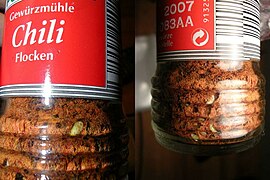Bread beetle
| Bread beetle | ||||||||||||
|---|---|---|---|---|---|---|---|---|---|---|---|---|

Bread beetle ( Stegobium paniceum ) |
||||||||||||
| Systematics | ||||||||||||
|
||||||||||||
| Scientific name | ||||||||||||
| Stegobium paniceum | ||||||||||||
| ( Linnaeus , 1758) |
The bread beetle ( Stegobium paniceum ) is a species from the rodent beetle family (Ptinidae). They used to be popularly known as bookworms.
features
Bread beetles are only about three millimeters long. The chitin armor is colored reddish brown all over the body. The body itself is oval. The wing covers possess not only an inconspicuous tightly fitting hair still a rough erect hair (double hair). Long rows of dots can be clearly seen on the wing covers. The head can be completely hidden under the shield of the thorax , which is hollowed out on the underside for this purpose (Fig. 3). The pronotum is completely canted on the sides (Fig. 2). The pronotum is simple, not arched in a humped manner and shows the widest point behind the middle. The antennae are eleven sections, the last three sections are greatly enlarged.
The bread beetle larvae are about five millimeters long. They are white with thick hair and a brown head.
Synonyms
- Anobium ferrugineum autumn, 1783
- Anobium ireos A. Villa & GB Villa, 1833
- Anobium minutum Fabricius, 1792
- Anobium nanum Küster, 1849
- Anobium obesum Melsheimer, 1845
- Anobium villosum Melsheimer, 1845
- Anobium tenuestriatum Say, 1825
- Cis bonariensis Steinheil, 1873
- Cis striatopunctatum Steinheil, 1873
- Ptinus rubellum Marsham, 1802
- Ptinus tenuicorne Marsham, 1802
- Ptinus testaceus Thunberg, 1784
- Ptinus upsaliensis Gmelin, 1790
Occurrence
The bread beetle is very widespread in Europe and is one of the cultural followers . It inhabits almost exclusively human settlements and there mainly buildings and processing rooms for the food industry, although due to its temperature requirements it is mostly dependent on heated rooms.
Way of life
Bread beetles are stored food pests . They occur all year round, although they tend to live in secret. The animals draw attention to themselves primarily through the damage that occurs. Among other things, they feed on baked goods, drugs and spices, as well as various dry parts of plants or animals. This leads to losses not only in the kitchen, but also in pharmacies or zoological collections. In the summer of 2009, the infestation by the bread beetle made it impossible to use large and important parts of the Augsburg city archive.
The larvae lead a similar way of life as the beetles. After several moults, they pupate in the food. The finished beetle hatches from the pupa. The bread beetle lives in an obligatory symbiosis with a yeast that is placed on the surface of the eggs from paired attachments of the female genital apparatus. The larvae become infected as soon as they consume the shell of the egg. The fungus likely creates vitamins for the beetle. The females lay about 100 eggs.
The species forms up to three generations a year, depending on the temperature.
Web links
Individual evidence
- ↑ H. Freude, KW Harde, GA Lohse: Die Käfer Mitteleuropas , Vol. 8. Spectrum Academic Publishing House in Elsevier, Munich 1966, ISBN 3-8274-0683-8 .
- ↑ a b Julius Kühn Institute: Pest portrait of the bread beetle - determination aid for stored pests. Retrieved July 30, 2018 .
- ↑ a b c d e f g h i j k l m Stegobium paniceum (Linnaeus 1758). Fauna Europaea, Version 1.3, April 19, 2007 , accessed on June 18, 2007 .
- ↑ cf. Augsburger Allgemeine: University historians fight for the city archive
- ↑ Jiři Zahradnik, Irmgard Jung, Dieter Jung et al .: Käfer Central and Northwestern Europe , Parey Berlin 1985, ISBN 3-490-27118-1 .




